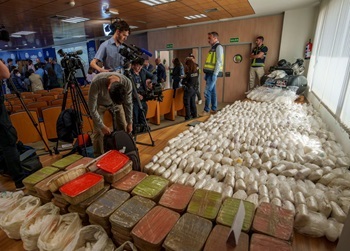Significant methamphetamine seizures in Europe demonstrate how Mexican criminal organizations are expanding their transit points and circle of clients into more lucrative markets.
On May 16, the Spanish National Police reported that agents had dismantled a drug trafficking network and seized 1,800 kilograms of methamphetamine in the Valencian Community, Spain.
SEE ALSO: Methamphetamine Traffickers in Mexico Become Global Wholesalers
The five arrested include one person allegedly associated with the Sinaloa Cartel and four transporters, reportedly hired to move the product to other European countries.
“The main supply point for synthetic drugs in European territory, which operated from Tenerife, Madrid, Valencia and Alicante, has been dismantled,” authorities announced in a press release.
There have been similarly large seizures in other European countries recently. In February, Irish authorities seized 500 kilograms of methamphetamine in the port of Cork, also allegedly linked to the Sinaloa Cartel, and bound for Australia as the final destination.
In 2020, authorities found 1.5 tons of Mexican methamphetamine trafficked to Slovakia via Croatia, and in 2019 a similar shipment of 1.9 tons was seized in Rotterdam.
Then in 2021, Spanish authorities and Europol dismantled a drug trafficking network operating in Spain and the Netherlands, which was accused of trafficking 2.5 tons of methamphetamine and 1.3 tons of cocaine. According to the investigation, the shipment was linked to Mexico’s Beltran Leyva Organization in an attempt to generate European demand for methamphetamine.
InSight Crime Analysis
Mexican methamphetamine has made strong inroads into the Oceania market in recent years, making Europe a valuable transit point and a potential market for expansion.
In April, the Australian Federal Police (AFP) estimated that, for the first time, North American methamphetamine production, the vast majority of which comes from Mexico, surpassed that of South Asia.
“The AFP estimates that at least 70% of the Australian methamphetamine market is currently supplied from North American production sources,” reported a police statement.
Between 2022 and 2023, the AFP and its foreign partners seized more than 23.6 tons of methamphetamine produced in North America destined for the Australian market. Of this amount, 4.36 tons of methamphetamine were seized in Australia and 19.33 tons abroad, including European countries.
Driving these operations is a significant price differential. While a kilogram of methamphetamine sells for as little as $656 in Mexico City, according to Australian intelligence sources, and for $5,000 in the United States, the price can reach $20,000 in European countries, and up to $190,000 in Oceania.
Europe has increasingly become one of the favored routes for methamphetamine bound for the lucrative Oceania market, according to reports from EMCDDA, Europol, and the DEA.
Methamphetamine use in Europe has also increased slightly in recent years. EMCDDA’s wastewater analysis revealed that two-thirds of the 59 European cities studied in 2021 and 2022 saw an increase in methamphetamine waste.
But the demand for other drugs such as cocaine or amphetamines, another less potent stimulant, remains much higher, and the methamphetamine market remains very small, UNODC research officer Thomas Pietschmann told InSight Crime.
“Europe is still a continent of amphetamines, not methamphetamines, but the proportion of methamphetamines has been increasing,” he added.
Most of the methamphetamine sold in the European Union is produced in European countries such as Holland, Belgium or the Czech Republic, creating competition for the Mexican product.
Although an increase in consumption would not necessarily imply a change in the European criminal landscape, it could offer new business opportunities for Mexican wholesalers.
“If there is a growth in demand for this drug, it seems more plausible to me that there will be a growth in local production and/or a growth in imports, but in the hands of European groups that are already bringing in, for example, cocaine,” Damian Zaitch, an associate professor at Utrecht University, told InSight Crime. “Both can continue to coexist.”
*Marío Saiz contributed to the reporting of this article.
Featured image: Spanish National Police display part of the 1,800 kilograms of methamphetamine seized on May 16. Credit: Manu Fernández / Associated Press.

